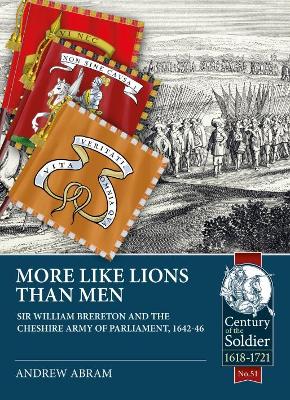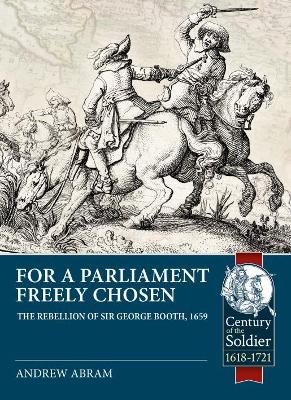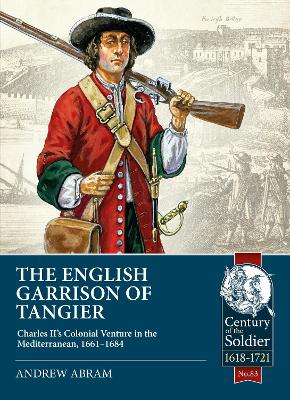Century of the Soldier
3 total works
Based on primary archival research (much of which remains unpublished), supported by fieldtrips to battlefields and castles, More Like Lions than Men represents the first focused and sustained study of the recruitment, organisation, payment, equipping, leadership and war service of the forces raised and maintained in the service of parliament in Cheshire between 1642 and 1646. The Cheshire army of parliament was commanded by the devout, energetic and strategically astute Sir William Brereton, MP for the county. As a important 'regional' force it undertook the extended war aims and strategy of the parliament in Cheshire (and in particular, its primary objective, the reduction and capture of the royalist stronghold of Chester). Led and trained by a number of officers of experience and ability (including Michael Jones, Robert Venables, and some professional soldiers, such as James Lothian), it often operated in conjunction with other forces and under various regional commands throughout the northwest, as well as the Midland counties, North Wales, Lancashire and Yorkshire, wherein its troops and companies served together or were 'brigaded' with others. These were bolstered in 1644 by the absorption of high quality, veteran troops of Charles I's army in Ireland, who had been captured at Nantwich and Liverpool.
Cheshire and the northwest were no backwaters during the first civil war, and on occasion Brereton's forces became embroiled in events of a more national complexion, such as the landing of the royalist army from Ireland in late 1643, the advance of Prince Rupert through the Welsh Marches, Cheshire and Lancashire during the summer of 1644, and the arrival of Charles I in a temporary relief of Chester 1645.Like other parliamentarian forces, the Cheshire troops were noted for their religious fervour, partly in that they were raised, shaped, motivated and led by radical independent and Presbyterian officers, as well as godly ministers. Yet despite its effectiveness and military experience, parts of the army suffered from pay arrears and subsequent mutinies, as well as organisational problems that stretched resources, and at points created breakdowns in discipline and moral. Moreover, Sir William Brereton's authority as commander-in-chief in Cheshire came under threat in 1645 in the form of divergent war aims and rivalries among subordinates.
The Cheshire army of parliament is well served by archival sources. This includes contemporary news-books, correspondence, warrants, petitions, accounts of sequestration committees and army officers, certificates of service and illustrations of cavalry standards, contained in various repositories and private collections, but especially The National Archives and the British Library. The five surviving volumes of letter books of Sir William Brereton remain invaluable to our understanding of the scope and day-to-day operations of Sir William and his army. Such sources present an invaluable, if largely untapped source for the centralised pay, equipping and composition of the Cheshire parliamentarian forces. Split into three broad sections, this book provides three chapters outlining up-to-date research on the military role of the army in Cheshire and beyond between autumn 1642 and spring 1646; the central part offers four chapters on the composition of the Cheshire forces, including recruitment, training and leadership, as well as the 'sinews of war' (money, ammunition and provisions), standards, clothing and equipment. The remaining section provides in-depth information on the combat units of Brereton's army, in addition to its 'support arms' of gunners, engineers, pioneers, intelligence services and chaplains.
More Like Lions than Men explores the context, nature and composition of the Cheshire forces indetail, in order to give credence to the notion that this was an effective, seasoned and important fighting force, albeit mainly on a regional stage. As such it adds significantly to our knowledge of the parliamentary war effort and civil war forces in the northwest of England and beyond, whilst appealing to anyone with an interest in military history, including academics, local historians, re-enactors and wargamers.
Cheshire and the northwest were no backwaters during the first civil war, and on occasion Brereton's forces became embroiled in events of a more national complexion, such as the landing of the royalist army from Ireland in late 1643, the advance of Prince Rupert through the Welsh Marches, Cheshire and Lancashire during the summer of 1644, and the arrival of Charles I in a temporary relief of Chester 1645.Like other parliamentarian forces, the Cheshire troops were noted for their religious fervour, partly in that they were raised, shaped, motivated and led by radical independent and Presbyterian officers, as well as godly ministers. Yet despite its effectiveness and military experience, parts of the army suffered from pay arrears and subsequent mutinies, as well as organisational problems that stretched resources, and at points created breakdowns in discipline and moral. Moreover, Sir William Brereton's authority as commander-in-chief in Cheshire came under threat in 1645 in the form of divergent war aims and rivalries among subordinates.
The Cheshire army of parliament is well served by archival sources. This includes contemporary news-books, correspondence, warrants, petitions, accounts of sequestration committees and army officers, certificates of service and illustrations of cavalry standards, contained in various repositories and private collections, but especially The National Archives and the British Library. The five surviving volumes of letter books of Sir William Brereton remain invaluable to our understanding of the scope and day-to-day operations of Sir William and his army. Such sources present an invaluable, if largely untapped source for the centralised pay, equipping and composition of the Cheshire parliamentarian forces. Split into three broad sections, this book provides three chapters outlining up-to-date research on the military role of the army in Cheshire and beyond between autumn 1642 and spring 1646; the central part offers four chapters on the composition of the Cheshire forces, including recruitment, training and leadership, as well as the 'sinews of war' (money, ammunition and provisions), standards, clothing and equipment. The remaining section provides in-depth information on the combat units of Brereton's army, in addition to its 'support arms' of gunners, engineers, pioneers, intelligence services and chaplains.
More Like Lions than Men explores the context, nature and composition of the Cheshire forces indetail, in order to give credence to the notion that this was an effective, seasoned and important fighting force, albeit mainly on a regional stage. As such it adds significantly to our knowledge of the parliamentary war effort and civil war forces in the northwest of England and beyond, whilst appealing to anyone with an interest in military history, including academics, local historians, re-enactors and wargamers.
Grounded in primary archival research and published sources, this book provides a focused, and up-to-date assessment of the rebellion aimed at overthrowing the recalled Rump Parliament, led by Sir George Booth in 1659. Although nominally part of a wider 'revolt' against the Cromwellian State, following the resignation of Richard Cromwell and the ending of the Protectorate, it has been usually regarded as a localised 'royalist' uprising aimed at restoring the Stuart Monarchy. As such, the reasons for the armed rebellion, in terms of the political, religious, and military objectives of its leaders, backers and participants have been often misunderstood or misrepresented. In a national and local context, there has been something of a lacuna in focused approaches to the topic over the past half a century. For a Parliament Freely Chosen challenges the view that the rebellion was local in nature, and poorly led, planned, and executed. Stress is placed on identifying and reconstructing the background, contacts and actions of Booth and the forces under their command, while re-assessing the military aspects of the revolt in Cheshire and its adjacent counties.
The book adds significantly to our knowledge of the causes, events and perceptions of the Booth rebellion, and will appeal to anyone with an interest in the Protectorate that followed the Wars of the Three Kingdoms and reactions to it, as well as the circumstances that contributed to the Restoration of the Stuart Monarchy in 1660. This includes academics, local historians, re-enactors and wargamers.
The book adds significantly to our knowledge of the causes, events and perceptions of the Booth rebellion, and will appeal to anyone with an interest in the Protectorate that followed the Wars of the Three Kingdoms and reactions to it, as well as the circumstances that contributed to the Restoration of the Stuart Monarchy in 1660. This includes academics, local historians, re-enactors and wargamers.


